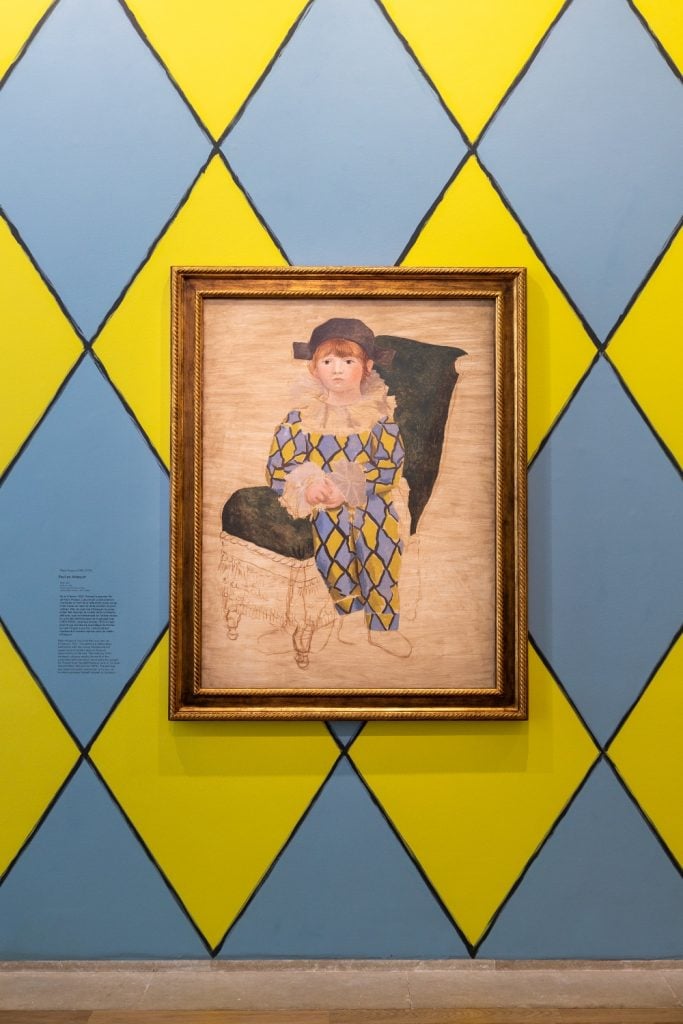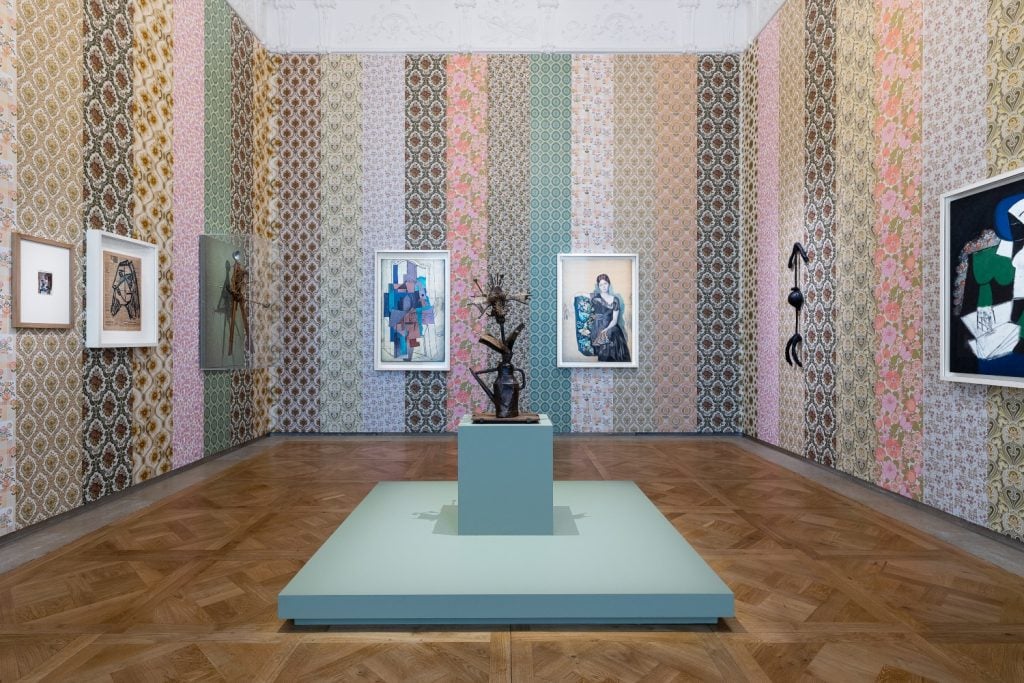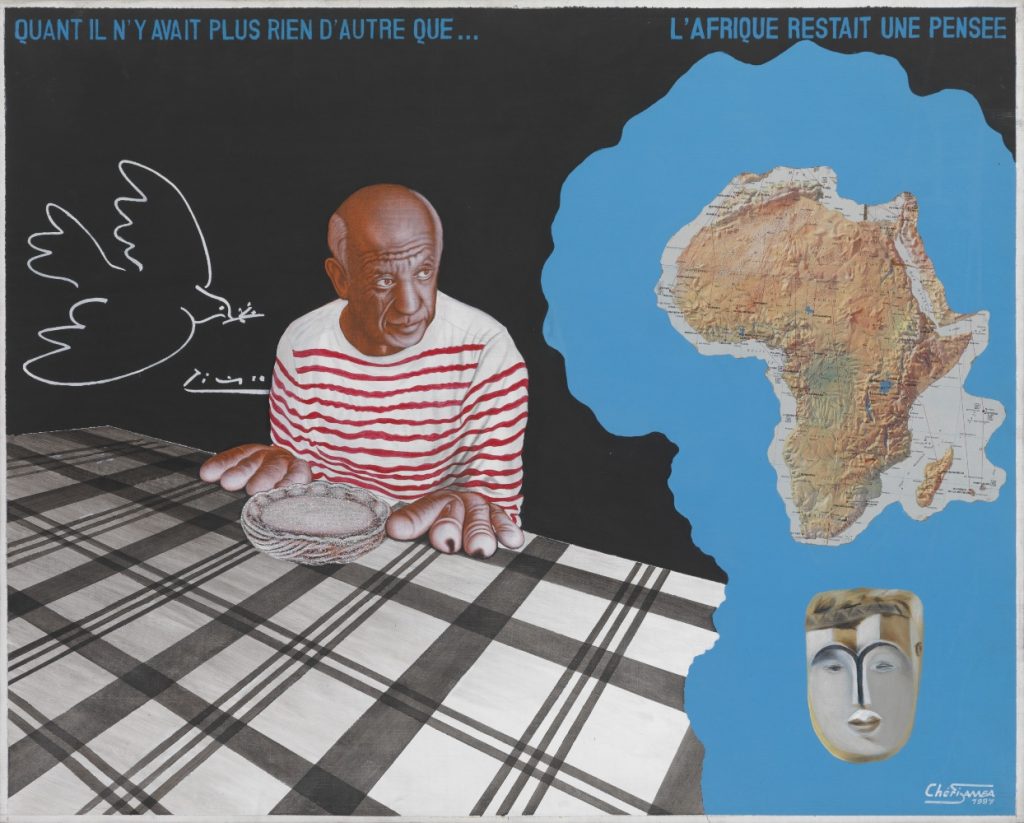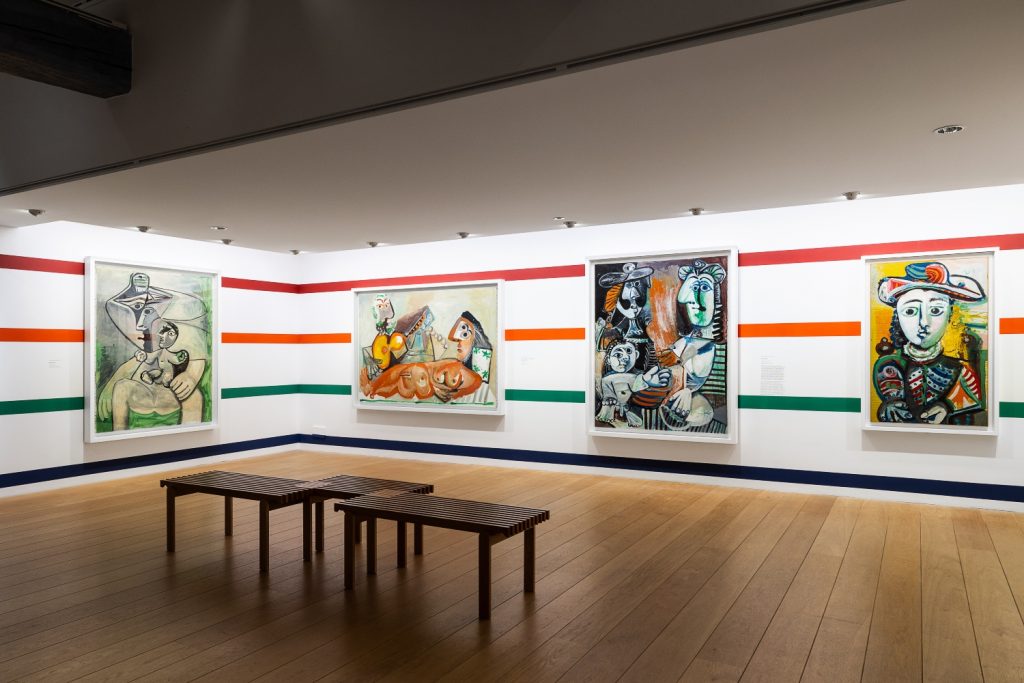In the 50 years since Picasso’s death in 1973, his profound influence on contemporary art and culture has shown no signs of slowing down, continuing to appear in new guises in the 21st century. This is the lens through which the many phases of his practice are reconsidered in a new show celebrating the anniversary at the Picasso Museum in Paris, which has been assembled with help from British fashion designer Paul Smith, who served as guest artistic director.
“Picasso Celebration” waves goodbye to the white cube in which we are all too accustomed to seeing modern art, instead giving us a suite of newly designed galleries that feel gimmicky but fun. Smith has noted his particular interest in appealing to younger audiences.

Pablo Picasso, Paulo as Harlequin (1924), hanging at the “Celebrate Picasso” exhibition in collaboration with Paul Smith at the Picasso Museum in Paris. Photo: © Vinciane Lebrun/Voyez-Vous and Succession Picasso 2023.
Early on in the survey, for example, Picasso’s obsession with the pantomime characters Harlequin and Pierrot, featured here in two large oil paintings and a few sketches, is brought vividly to life as the colorful patterns from the subjects’ outfit jump out from the canvas and are splashed across the neighboring walls.
Touches like these jazz up an otherwise conventional, roughly chronological retelling of Picasso’s story—starting with the Blue Period and Cubism before examining works relating to his most famous masterpieces like Demoiselles d’Avignon (1907) and Guernica (1937)—so that it feels genuinely fresh and easy to engage with.

Installation view of “Celebrate Picasso,” in collaboration with Paul Smith at the Picasso Museum in Paris. Photo: © Vinciane Lebrun/Voyez-Vous and Succession Picasso 2023.
Among these already familiar works, however, is the inclusion of pieces by living artists who are strongly inspired by Picasso or interested in similar themes. One example can be found in a room dedicated to the ethnographic objects of African and Oceanic origin that Picasso collected from markets in Paris, a selection of which are included in the show. Picasso was seeking a radical break from Western tradition, but today his use of the objects has been problematized by a post-colonial critical lens.
Welcoming more contemporary perspectives, the museum has staged these items alongside Landscapes of My Childhood Remembered (2015), a triptych of collages by the Nigerian artist Obi Okigbo. The artist’s use of traditional Igbo masks and sculptures relates to her exploration of a local custom known as the Mbari rite.
Elsewhere, a powerful 1997 work by the Congolese painter Chéri Samba is a direct response to Picasso’s thorny legacy. Standing in for the archetypal Western artist, his Picasso looks greedily over at the continent of Africa and its culture, represented here by a traditional mask. The painting honors the many African artists whose work has been othered, fetishized, and consumed without proper representation in Western museums.

Chéri Samba, Quand il n’yavait plus rien d’autre que… L’Afrique restait une pensée (1997). Photo: © Florian Kleinefenn, courtesy Galerie MAGNIN-A.
Additions like these are part of a wider strategy on the part of the museum to continue to recontextualize Picasso’s practice for new generations. The result is that even those already familiar with the gems of this collection can expect to keep discovering something new.
Nothing could be more of-the-moment than drawing a connection between groundbreaking modern and contemporary art movements and other art forms. In recent years, many luxury and high fashion brands have been clamoring to be associated with the world’s best-loved artists, including Louis Vuitton’s much-discussed partnership with Yayoi Kusama.

Installation view of “Celebrate Picasso,” in collaboration with Paul Smith at the Picasso Museum in Paris. Photo: © Vinciane Lebrun/Voyez-Vous and Succession Picasso 2023.
Smith himself is represented by a multicolored rug leading visitors from the second floor to the third floor. Otherwise, the revered designer’s perspective is communicated almost entirely via the wacky color schemes.
“Truthfully, l have little academic knowledge of Picasso, so the project is very much about visual and spontaneous associations,” he told the museum’s director Cécile Debray and head conservator Joanne Snrech during an interview for the exhibition’s catalogue. “I’m a very visual person, so it always come back to approaching things in a visual way.”
“In a way, I’m covering myself from potential criticism by some of the more academic connoisseurs of Picasso in the art world, who might think this exhibition is disrespectful in some way,” he added.
Delicately handling the complicated public image, this new exhibition leaves us with little doubt that Picasso’s influence will remain strong for at least another 50 years into the future.
“Picasso Celebration: The Collection in a New Light!,” under the artistic direction of Paul Smith, runs until August 27, 2023.
More Trending Stories:
A Wall Street Billionaire Shot Himself in His Family Office. His Death Is Reverberating in the Museum World, and the Art Market
Researchers in Vietnam Discovered That Two Deer Antlers Languishing in Museum Storage Are Actually 2,000-Year-Old Musical Instruments
Ontario Police Have Arrested Eight People Suspected of Forging Thousands of Artworks Attributed to Indigenous Artist Norval Morrisseau
A Pair of Climate Activists in Scotland Smashed and Spray-Painted a Glass Case Housing ‘Braveheart’ Knight William Wallace’s Sword
We Asked ChatGPT About Art Theory. It Led Us Down a Rabbit Hole So Perplexing We Had to Ask Hal Foster for a Reality Check
Dutch Police Are Closing In on the So-Called ‘Pink Panther Gang’ Behind the Astonishing Daytime Diamond Heist at TEFAF Maastricht
What I Buy and Why: Digital Collectors Pablo Rodríguez-Fraile and Desiree Casoni on the State of NFT Art and Their Own Tokenized Acquisitions
Art Industry News: Rijksmuseum Pauses Ticket Sales for Its Vermeer Blockbuster After Fierce Demand Crashes Its Website + Other Stories













